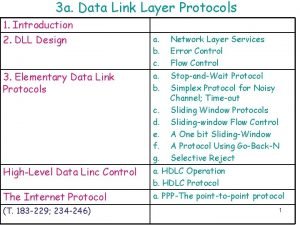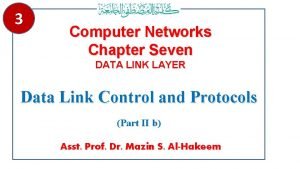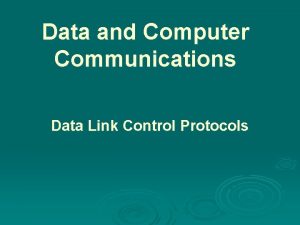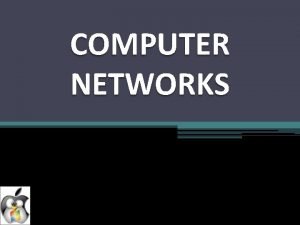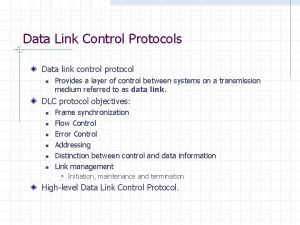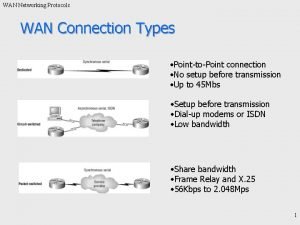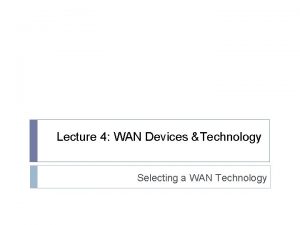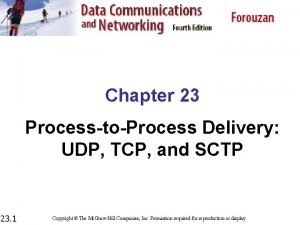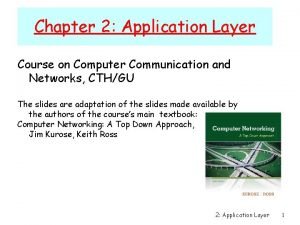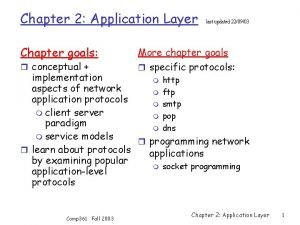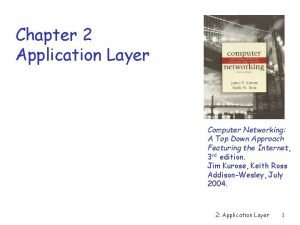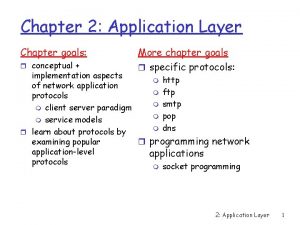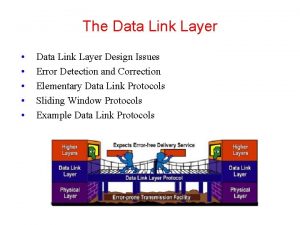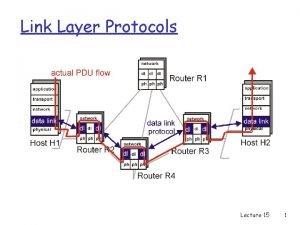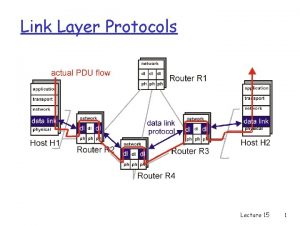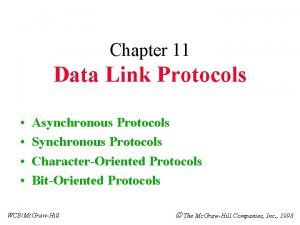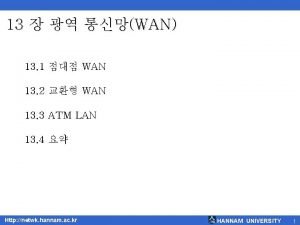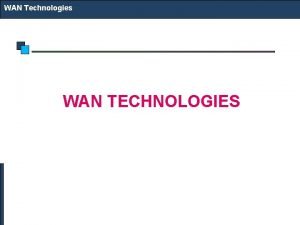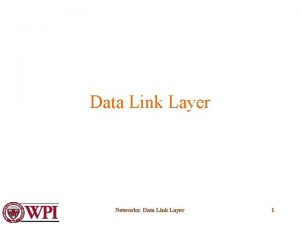Lecture 8 WAN Data Link Layer Protocols Asynchronous
























- Slides: 24

Lecture 8: WAN Data Link Layer Protocols Asynchronous Transfer Mode (ATM) 1 nd semester 1438 -1439 By: Adal ALashban 1

Overview - Promising technology in early 90 s (why? ). - Connection-oriented (virtual circuits). - Support for Qo. S (reserve bandwidth and buffer space for each VC at switches). 2

ATM - ATM: is a high-speed networking standard designed to support both voice and data communications. - ATM is normally utilized by Internet service providers on their private long-distance networks. - ATM operates at the data link layer (Layer 2 in the OSI model) over either fiber or twisted-pair cable. 3

Areas of Application - Infrastructure: LANs and Backbones. - Asynchronous transfer mode (ATM): is a high-performance, celloriented switching and multiplexing technology that utilizes fixed-length packets to carry different types of traffic. - ATM is a technology that will enable carriers to capitalize on a number of revenue opportunities through multiple ATM classes of services; high-speed local-area network (LAN) interconnection; voice, video, and future multimedia applications in business markets in the short term; and in community and residential markets in the longer term. 4

Circuit Switching and Packet Switching - ATM is circuit switched; because it establishes virtual circuits for communication. - At the same time, the virtual circuits are established over packet switched networks. - As such, it combines the benefits of circuit switched and packet switched technologies. 5

ATM Usage and Bandwidth - In theory, ATM can be deployed from small LANs to very large WANs. At present, it is used mostly on backbones, but this may change in the future with declining prices for ATM equipment. - ATM deployments can operate at speeds starting in the Mbps range scaling up to Gbps range. Speed wise, it is very scalable. 6

ATM’s Efficiency - It is an asynchronous technology and it uses the links based on the need for information to be transmitted. - ATM carries information based on fixed length cells. Compare this to the other packet switching technologies such as Frame Relay etc. where each packet may be of a different length. - The length of each cell is 53 Bytes. First 5 bytes are used as the cell header. Next 48 bytes are used as the payload carrying the data. 7

ATM Cell Format 5 Bytes Header 48 Bytes Payload (Data) 8

Fixed Length Cell Advantage 1 - Delay or latency is significantly reduced. ATM is therefore suited for voice and video transmission. 2 - Fixed length cells make it easier to switch data across multiple networks. ATM networks are built based on switches and not routers. 3 - Fixed length cell is similar to container based road transportation. Some parallels can be drawn with respect to the advantage of fixed length transportation based on the benefits of container transportation. 9

Asynchronous Transfer Mode (ATM) Voice Data packets MUX Wasted bandwidth Images TDM 4 3 2 1 ATM ` 4 3 1 3 2 2 1 10

User Applications Voice Video Voice Data BISDN Services Video Data BISDN Services Reassembly Segmentation Demultiplexing Multiplexing Workstation H H ATM Network Workstation H H H 11

ATM Devices - ATM networks are built around two categories of devices: 1 - ATM Switch. 2 - ATM end-point. - An ATM switch can be connected to either another ATM switch or and ATM end-point. 12

1 - ATM Switches and Interfaces - ATM switch supports three types of interfaces: 1 - User-Network Interface (UNI). Connects an ATM end-point to a switch. 2 - Network-Network Interface (NNI). Connects two ATM switches. 3 - Broadband Inter-Carrier Interface (BICI). Connects two public switches from different service providers. 13

Public and Private Interfaces - UNI and NNI can further be divided to two types. - One is known as the private type and the other is known as the public type. Private Public UNI Connects an ATM end-point to a 1 - Connects an ATM end-point to a public ATM private ATM switch. 2 - Connect private ATM switch to public ATM switch. NNI Connects two ATM switches within the same private organization. Connects two ATM switches within the same public organization. 14

Public and Private Interfaces 15

2 - ATM End-Points - Will contain and ATM end-point adapter. - Examples of ATM end-points: Workstations. LAN switches. Routers. DSU/CSU Units. Video Coder-Decoders (CODECs). 16

Virtual Connection Composition - There can be a number of virtual paths (VP) along a physical connection (Transmission Path). - Also there can be a number of virtual circuits (VC) within a virtual path. 17

VPIs and VCIs - ATM connection identifiers: 8 b VPI + 16 b VCI - Two-level hierarchy: Virtual paths are used between major network nodes. Virtual circuits are multiplexed in same virtual paths. - Objective: backbone switches need smaller VC table. 18

ATM Cell Structure Bits: 0 7 Flow Control VPI (First 4 bits) VPI (Last 4 bits) VCI (First 4 bits) VCI (Middle 8 bits) VCI (Last 4 bits) Payload PRIO type Cyclic Redundancy Check 48 Data Octets start here 19

ATM Protocol Architecture - ATM Adaptation Layer (AAL): the protocol for packaging data into cells is collectively referred to as AAL. - Must efficiently package higher level data such as voice samples, video frames and datagram packets into a series of cells. 20

User information AAL ATM ATM PHY PHY … End system Network End system 21

ATM Architecture - An AAL is further divided into: 1 - The Convergence Sublayer (CS): manages the flow of data to and from SAR sublayer. 2 - The Segmentation and Reassembly Sublayer (SAR): breaks data into cells at the sender and reassembles cells into larger data units at the receiver. 22

Segmentation And Reassembly (SAR) AAL … … ATM - Also referred to as “fragmentation and reassembly” (in the IP context). - SAR is performed by ATM Adaptation Layer (AAL). AAL attaches an additional header to the packet needed for reassembly at the receiver. Five different AAL protocols were defined; AAL 5 was the most popular in data networks. 23

Thank You 24
 Ppp data link
Ppp data link Stop-and-wait arq
Stop-and-wait arq Data link layer protocols for noisy and noiseless channels
Data link layer protocols for noisy and noiseless channels Flow control protocols in data link layer
Flow control protocols in data link layer Data link layer design issues
Data link layer design issues Elementary data link protocols in computer networks
Elementary data link protocols in computer networks Data link layer design issues
Data link layer design issues Flow control protocols
Flow control protocols Wan connection types
Wan connection types Atm wan technology
Atm wan technology Private wan
Private wan Presentation layer design issues
Presentation layer design issues Tcp and sctp are both layer protocols
Tcp and sctp are both layer protocols Functions of session layer
Functions of session layer Application layer protocols
Application layer protocols Application layer protocols
Application layer protocols Presentation layer protocols
Presentation layer protocols Application layer protocols
Application layer protocols Application layer protocols
Application layer protocols Application layer protocols
Application layer protocols Application layer protocols
Application layer protocols Data link layer design issues
Data link layer design issues Materi data link layer
Materi data link layer Deauth attack
Deauth attack Apa itu data link layer
Apa itu data link layer

